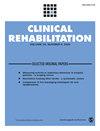新发虚拟呼吸道传染病患者康复干预的有效性:系统回顾与元分析
IF 2.6
3区 医学
Q1 REHABILITATION
引用次数: 0
摘要
数据来源截至 2023 年 12 月 30 日对七个数据库(MEDLINE、EMBASE、Cochrane Library、PEDro、MedRxiv、CNKI、万方)进行的系统性回顾。回顾方法评估了 101 项关于呼吸功能、运动能力和生活质量的研究(9593 名参与者)。采用 Cochrane 协作组织的偏倚风险工具评估随机对照试验(RCT)的方法学质量,采用纽卡斯尔-渥太华量表(NOS)评估观察性研究和非 RCT 研究的方法学质量,采用 NIH 质量评估工具评估前后研究的方法学质量。康复干预明显改善了呼吸功能,这体现在博格量表(MD,-1.85;95% CI,-3.00 至 -0.70,低度确定性)、mMRC 呼吸困难量表(MD,-0.45;95% CI,-0.72 至 -0.18,低度确定性)和多维呼吸困难-12 量表(MD,-4.64;95% CI,-6.54 至 -2.74,中度确定性)上。六分钟步行测试(MD,38.18;95% CI,25.33-51.03,中等确定性)和坐立测试(MD,3.04;95% CI,1.07-5.01,低确定性)的结果表明,运动能力也有所提高。未来的研究应重点关注个性化康复工作、利用远程技术辅助项目、提高研究质量以及识别特定亚组,为其量身定制康复策略,以实现幸存者的最佳康复效果。本文章由计算机程序翻译,如有差异,请以英文原文为准。
Effectiveness of Rehabilitation Interventions in Individuals With Emerging Virtual Respiratory Tract Infectious Disease: A Systematic Review and Meta-Analysis
ObjectiveAssessing rehabilitation effectiveness for persistent symptoms post-infection with emerging viral respiratory diseases.Data sourcesSystematic review of seven databases (MEDLINE, EMBASE, Cochrane Library, PEDro, MedRxiv, CNKI, Wanfang) until 30 December 2023.Review methodsEvaluated 101 studies (9593 participants) on respiratory function, exercise capacity, and quality of life. Methodological quality was assessed using the Cochrane Collaboration's Risk of Bias tool for randomized controlled trials (RCTs), the Newcastle-Ottawa Scale (NOS) for observational studies and non-RCTs, and the NIH Quality Assessment Tools for before-after studies.ResultsThe most common rehabilitation program combined breathing exercises with aerobic exercise or strength training. Rehabilitation interventions significantly enhanced respiratory function, as evidenced by improvements on the Borg Scale (MD, −1.85; 95% CI, −3.00 to −0.70, low certainty), the mMRC Dyspnea Scale (MD, −0.45; 95% CI, −0.72 to −0.18, low certainty), and the Multidimensional Dyspnoea-12 Scale (MD, −4.64; 95% CI, −6.54 to −2.74, moderate certainty). Exercise capacity also improved, demonstrated by results from the Six-Minute Walk Test (MD, 38.18; 95% CI, 25.33–51.03, moderate certainty) and the Sit-to-Stand Test (MD, 3.04; 95% CI, 1.07–5.01, low certainty).ConclusionRehabilitation interventions are promising for survivors of viral respiratory diseases, yet gaps in research remain. Future investigations should focus on personalizing rehabilitation efforts, utilizing remote technology-assisted programs, improving research quality, and identifying specific subgroups for customized rehabilitation strategies to achieve the best outcomes for survivors.
求助全文
通过发布文献求助,成功后即可免费获取论文全文。
去求助
来源期刊

Clinical Rehabilitation
医学-康复医学
CiteScore
5.60
自引率
6.70%
发文量
117
审稿时长
4-8 weeks
期刊介绍:
Clinical Rehabilitation covering the whole field of disability and rehabilitation, this peer-reviewed journal publishes research and discussion articles and acts as a forum for the international dissemination and exchange of information amongst the large number of professionals involved in rehabilitation. This journal is a member of the Committee on Publication Ethics (COPE)
 求助内容:
求助内容: 应助结果提醒方式:
应助结果提醒方式:


